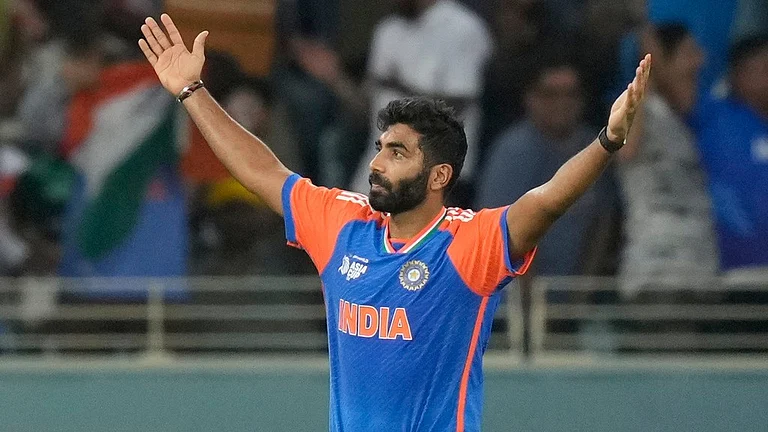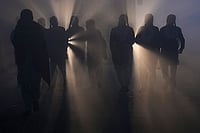So dull, prosaic, pedantic and pulchritudinous is Kakar's 'fiction' that one almost 'sees' the invisible hand of a copywriter advising him, maybe, to lead with a slightly more souped up opening chapter, integrating a slightly more graphic description of a sexual encounter between the protagonist of the novel (a self-inducted shishya of the sage Vatsyayana at his Seven Leaf hermitage and a courtesan adept in the erotic arts). Even this laboured and mandatory foreplay is unable to take this highly self-conscious literary endeavour to any mutually satisfactory climax. It's ironic then to encounter all those subtle references to premature ejaculations and shrivelling penises.
To take a line from Vatsyayana, Kakar needs to be informed that "not only in erotics", but in fiction-writing too, "theory is fundamental, even if divorced from practice". While Kakar exhibits vast research and theoretical grasp of the context of the Kamasutra—the 17 works on the erotic sciences and their 42 commentaries which Vatsyayana, the "ascetic of desire", had to delve into before putting together his own treatise—there is no evidence of his undertaking any study on the art of fictionalising. With the result that while we are inundated with copious scholarly references—from Dattka's 'on prostitutes', Suvarnanabha's 'erotic approaches', Ghotakamukha's 'the art of seduction', Gondardiya's 'on wives', Kuchumara's 'occult practices', Charayana's 'general remarks on sexuality', and the Babhravyas' standard work 'Kamasutra'—there is pretty little evidence that the author has any familiarity with, say, The Arabian Nights or even D.H. Lawrence.
The narrative seeks to construct the childhood and youth of Vatsyayana, the various impulses that drew him towards an exercise in categorising and classifying the sexual field, his adolescent infatuation with courtesan-aunt Chandrika, his adult admittance into the inner circle of king Udayana of Kausambi, his apprenticeship in the hermitage of Mihirpal, his sexual initiation in the bed of his guru's young wife Gauri, his marriage to King Udayana's sister-in-law Malavika, and the fated liaison between Malavika and the novel's protagonist. This is narrated with a dreary excess of descriptivity and desultory detail, providing neither literary nor psychological insights into any of the numerous characters strewn about the novel—least of all Vatsyayana. The very construction of the novel—with its academic tone, its bumpy monologues, its clumsy transitions, its hasty withdrawals from etching credible characters, and its embarrassingly simplistic devices—lands it squarely in the category of a dud scud.
My response is based, essentially, on two arguments. One, I think I share common cause with millions of middle-class Indians who have spent a stealthy and surreptitious youth poring through pirated, cheaply printed editions of the Kamasutra in the inner, dark recesses of innumerable bookshops, in fervent hope of illicit knowledge. An increasingly patriarchal, therefore prurient, society instilled in me, along with the other millions, an exquisite horror of the Body. Its immediate corollary in the male was a manifest misogyny masquerading as puritanism. The Kamasutra was, thus, a bridge that led you to the value-paradigms of another time.While Kakar does well in highlighting this special and liberational emphasis in the Kamasutra of female sexuality, he fails in putting flesh on the body and personality of its author. He even fails to underline the self-evident fact that the author of the most comprehensive sex manual was, himself, a sexual novice, a deep conservative and a reactionary upholder of the values of patriarchy, family and feudal hierarchy.
MY second argument stems from the position that the Kamasutra, in fact, attempts a rationalising of sexuality, its cold and objective tone being the very antithesis of sensuality where the surge of the body can overpower the dictates of the mind. In this, the Kamasutra is on par with several classical texts of the half millennium between the first and sixth century AD, which saw the growth and flowering of a whole range of cognitive systems in India, which set about processing knowledge—codifying, naming, defining, illustrating. Despite all the disputed datings, the Kamasutra is of a piece with Bharata's Natyashastra, Patanjali's Yogasutra, Kautilya's Arthashastra, Panini's Vyakaranashastra or Vyachrapada's treatise on martial arts. It is the simultaneous emergence of disciplines and theory of disciplines. Though many of the above-mentioned disciplines deal with the body, this period of history chose to apply mind to it. It was like a broad social stocktaking of practices, methods, processes. All these completely bypassed the chemistry and alchemy of change—the relentless assault of the irrational on the rational; the periodic capture of our senses by subliminal forces beyond our control or comprehension. By sticking close to the Kamasutra's attempt to rationalise the sex drive, Kakar creates a Vatsyayana who sounds more like "the loin in winter". While the fiction is there, what is absent is the fantasy. As he himself has quoted Vatsyayana, "the fantasies invented by man in grip of sexual excitement are unimaginable even in dreams".
After some 11 important tomes that explore the psychological innards and the latent and manifest sexuality in Indian society, it is distressing that Sudhir Kakar is not able to clue on to and ignite the character of the man who started it all. It needed some more imagination to portray a man who even foresaw Andrea Dowrkin: "Sexual intercourse can be viewed as a kind of combat, and eroticism both as a contest and a perversion" (Kamasutra).
What the subject needed was more engaged journey through the erotic spaces of the Indian psyche with a more intense lingering over the nuances of the female voices to help constitute the Vatsyayana in all of us. All Kakar ends up doing is producing a tourist guide to the dry docks where massive ships are parked—all out of their depth


























